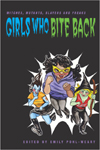Girls
Who Bite Back: Witches, Mutants, Slayers and Freaks
edited by Emily Pohl-Weary
Sumach Press, 2004
Reviewed by Anne Borden
 In
this new anthology, Emily
Pohl-Weary presents the work of emerging North American female
artists, writers and critics in speculative fiction (sf), a genre
encompassing fantasy and science fiction that publishers are
increasingly marketing towards women and girls. To its detriment, Girls
Who Bite Back is heavy with banal cultural criticism, but the
fiction sections are definitely worth the read. In
this new anthology, Emily
Pohl-Weary presents the work of emerging North American female
artists, writers and critics in speculative fiction (sf), a genre
encompassing fantasy and science fiction that publishers are
increasingly marketing towards women and girls. To its detriment, Girls
Who Bite Back is heavy with banal cultural criticism, but the
fiction sections are definitely worth the read.
Some of the collection’s graphic gems
include Meagan Crump and Matthew Blackett’s comic riff on
gentrification, (The Parkdale 3) and Lisa Smolkin and Sonja
Ahlers’ riveting, post-feminist zine art. Fiction by A.M. Dellamonica
and Carma Livingstone radically challenges the usual stock characters of
sf (teachers, large corporations, mothers, scientists and even
superheroines). Larissa Lai’s The Combing is a painful coming
of age story that meditates on power, family and the bond between female
friends.
Perhaps the strongest story is Kij
Johnson’s Myth Girls, a haunting dystopia about life
"underground" that is as much a cyberpunk dystopia as it is a
straight up story about living on the streets today. If you’re going
to stand in the bookstore aisle and read one story, make it Myth
Girls.
Candra Gill’s essay Cuz the Black
Chick Always Gets it First: Dynamics of Race in Buffy the Vampire Slayer
focuses on representations of indigenous cultures and African Americans
in the massively popular WB show. Drawing on Samuel L. Delany and Kent
Ono’s post-colonial theory, Gill focuses on the life and death of
Willow and other African American characters as only an exacerbated fan
could – at once harshly critical and yet cautiously hopeful that new,
more liberated characters will emerge. Likewise, fan Nikki Stafford
looks at "the comic book origins of TV’s superheroines,"
offering a media savvy take on television writing and representations of
superheroines from Wonder Woman to Xena.
With a few exceptions, however, the
book’s cultural criticism is mostly uninspiring – not unlike a stack
of C-grade Women’s Studies 101 essays. Many essay titles are
red-flagged with first person pronouns ("Buffy, Angelina and Me,"
"The Cyborg, The Alien and Me," "My Quest
for a Female Action Hero") and Pohl-Weary’s pen was not strong
enough to edit out obvious gaffes (e.g., "This was the era of World
War II and propaganda, a time when it was clear who was the enemy and
who was an ally" or "From early childhood, we learn to see
ourselves and be seen, as we form our sense of self. In our society,
identity so often is ill-defined by consumer choices"). There’s
some great new information about the history of comics in these essays,
but it’s mostly lost.
Also, much of the writing comes across
as unconfident, undermining the empowerment model that has vaulted the
best female talent in the genre. "Nobody listened to me," is
not a compelling refrain for an emerging writer, and too much energy is
wasted in defensive posturing against male-dominated comic culture. Most
sf readers want work that actually takes risks with gender, as evidenced
by the popularity of Ursula K. LeGuin, Octavio Butler, Delany and Ann
Rice.
The most compelling and popular sf
artists and critics are of course undistracted by the so-called sex war
- they’re busy making great work, and if it happens to destabilize
dominant notions of gender, well then so much the better. The edgiest
fiction in Girls Who Bite Back is at once evocative and
challenging, fiercely re-presenting gender, class and the politics of
power with a creative fury that bites. In the good sense of the word.
Anne Borden lives in
Toronto, where she works as a writer and editor. |